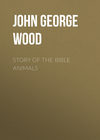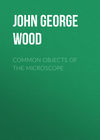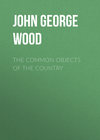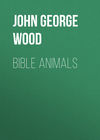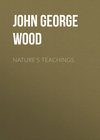Czytaj książkę: «Story of the Bible Animals», strona 30

THE CRANE
Various passages in which the Crane is mentioned—Its migratory habits, and loud voice—Geographical range of the Crane—Its favourite roosting-places—Size of the Crane, and measurement of the wings—The Crane once used as food—Plumes of the Crane and their use—Structure of the vocal organs—Nest and eggs of the Crane.
In the description of the dove and the swallow two passages have been quoted in which the name of the Crane is mentioned, one referring to its voice, and the other to its migratory instinct. The first passage occurs in Isa. xxxviii. 14: "Like a crane or swallow, so did I chatter;" and the other in Jer. viii. 7: "The turtle and the crane and the swallow observe the time of their coming."

THE CRANE.
It is rather remarkable that in both these cases the word "Crane" is used in connexion with the swallow, or rather the swift, and that in both instances the names of the birds should have been interchanged. If we refer to the original of these passages, we shall find that the former of them would run thus, "Like a sis or an agur," and the latter thus, "The turtle and the sis and the agur." That in these passages the interpretation of the words sis and agur have been interchanged has already been mentioned, and, as the former has been described under the name of swallow or swift, we shall now treat of the latter under the title of Crane.
The species here mentioned is the common Crane, a bird which has a very wide range, and which seeks a warm climate on the approach of winter.
The Crane performs its annual migrations in company, vast flocks of many thousand individuals passing like great clouds at an immense height, whence their trumpet-like cry is audible for a great distance round, and attracts the ear if not the eye to them. Thus we have at a glance both the characteristics to which reference is made in the Scriptures, namely, the noisy cry and the habit of migration.
It is a very gregarious bird, associating with its comrades in flocks, just as do the starlings and rooks of our own country, and, like these birds, has favourite roosting-places in which it passes the night. When evening approaches, the Cranes may be seen in large flocks passing to their roosting-places, and, on account of their great size, having a very strange effect. A fair-sized Crane will measure seven feet across the expanded wings, so that even a solitary bird has a very imposing effect when flying, while that of a large flock of Cranes on the wing is simply magnificent.
The spots which the Crane selects for its roosting-places are generally of the same character. Being in some respects a wary bird, though it is curiously indifferent in others, it will not roost in any place near bushes, rocks, or other spots which might serve to conceal an enemy. The locality most favoured by the Crane is a large, smooth, sloping bank, far from any spot wherein an enemy may be concealed. The birds keep a careful watch during the night, and it is impossible for any foe to approach them without being discovered. The Crane is noisy on the wing, and, whether it be soaring high over head on its long migratory journeys, or be merely flying at dusk to its roosting-place, it continually utters its loud, clangorous cry.
The food of the Crane is much like that of the heron, but in addition to the frogs, fish, worms, and insects, it eats vegetable substances. Sometimes it is apt to get into cultivated grounds, and then does much damage to the crops, pecking up the ground with its long beak, partly for the sake of the worms, grubs, and other creatures, and partly for the sake of the sprouting seeds.
Although by reason of its scarcity the Crane has been abandoned as food, its flesh is really excellent, and in former days was valued very highly.
Like the egret, the Crane is remarkable for the flowing plumes of the back, which fall over the tail feathers, and form a train. These feathers are much used as plumes, both for purposes of dress and as brushes or flappers wherewith to drive off the flies. By reason of this conformation, some systematic zoologists have thought that it has some affinity to the ostrich, the rhœa, and similar birds, and that the resemblance is strengthened by the structure of the digestive organs, which are suited to vegetable as well as animal substances, the stomach being strong and muscular.
The peculiar voice of the Crane, which it is so fond of using, and to which reference is made in the Scriptures, is caused by a peculiar structure of the windpipe, which is exceedingly long, and, instead of going straight to the lungs, undergoes several convolutions about the breast-bone, and then proceeds to the lungs.
The Crane makes its nest on low ground, generally among osiers or reeds, and it lays only two eggs, pale olive in colour, dashed profusely with black and brown streaks.


THE STORK
Signification of the Hebrew word Chasidah—Various passages in which it is mentioned—The Chasidah therefore a large, wide-winged, migratory bird—Its identification with the Stork—The Stork always protected.
In the Old Testament there are several passages wherein is mentioned the word Chasidah.
The Authorized Version invariably renders the word Chasidah as "Stork" and is undoubtedly right.
In Buxtorf's Lexicon there is a curious derivation of the word. He says that the word Chasidah is derived from chesed, a word that signifies benevolence.
According to some writers, the name was given to the Stork because it was supposed to be a bird remarkable for its filial piety; "for the storks in their turn support their parents in their old age: they allow them to rest their necks on their bodies during migration, and, if the elders are tired, the young ones take them on their backs." According to others, the name is given to the Stork because it exercises kindness towards its companions in bringing them food; but in all cases the derivation of the word is acknowledged to be the same.
Partly in consequence of this idea, which is a very old and almost universal one, and partly on account of the great services rendered by the bird in clearing the ground of snakes, insects, and garbage, the Stork has always been protected through the East, as it is to the present day in several parts of Europe. The slaughter of a Stork, or even the destruction of its eggs, would be punished with a heavy fine; and in consequence of the immunity which it enjoys, it loves to haunt the habitations of mankind.
In many of the Continental towns, where sanitary regulations are not enforced, the Stork serves the purpose of a scavenger, and may be seen walking about the market-place, waiting for the offal of fish, fowls, and the like, which are simply thrown on the ground for the Storks to eat. In Eastern lands the Stork enjoys similar privileges, and we may infer that the bird was perfectly familiar both to the writers of the various Scriptural books in which it was mentioned, and to the people for whom these books were intended.
When they settle upon a tract of ground, the Storks divide it among themselves in a manner that seems to have a sort of system in it, spreading themselves over it with wonderful regularity, each bird appearing to take possession of a definite amount of ground. By this mode of proceeding, the ground is rapidly cleared of all vermin; the Storks examining their allotted space with the keenest scrutiny, and devouring every reptile, mouse, worm, grub, or insect that they can find on it. Sometimes they will spread themselves in this manner over a vast extent of country, arriving suddenly, remaining for several months, and departing without giving any sign of their intention to move.

STORKS AND THEIR NESTS.
The wings of the Stork, which are mentioned in Holy Writ, are very conspicuous, and are well calculated to strike an imaginative mind. The general colour of the bird is white, while the quill feathers of the wings are black; so that the effect of the spread wings is very striking, an adult bird measuring about seven feet across, when flying. As the body, large though it may be, is comparatively light when compared with the extent of wing, the flight is both lofty and sustained, the bird flying at very great height, and, when migrating, is literally the "stork in the heavens."
Next we come to the migratory habits of the Stork.
Like the swallow, the Stork resorts year after year to the same spots; and when it has once fixed on a locality for its nest, that place will be assuredly taken as regularly as the breeding-season comes round. The same pair are sure to return to their well-known home, notwithstanding the vast distances over which they pass, and the many lands in which they sojourn. Should one of the pair die, the other finds a mate in a very short time, and thus the same home is kept up by successive generations of Storks, much as among men one ancestral mansion is inhabited by a series of members of the same family.
So well is this known, that when a pair of Storks have made their nest in a human habitation their return is always expected, and when they arrive the absentees are welcomed on all sides. In many countries breeding-places are specially provided for the Storks; and when one of them is occupied for the first time, the owner of the house looks upon it as a fortunate omen.
The localities chosen by the Stork for its nest vary according to the surrounding conditions. The foundation which a Stork requires is a firm platform, the more elevated the better, but the bird seems to care little whether this platform be on rocks, buildings, or trees. If, for example, it builds its nest in craggy places, far from the habitations of man, it selects some flat ledge for the purpose, preferring those that are at the extreme tops of the rocks. The summit of a natural pinnacle is a favourite spot with the Stork.
In many cases the Stork breeds among old ruins, and under such circumstances it is fond of building its nest on the tops of pillars or towers, the summits of arches, and similar localities. When it takes up its abode among mankind, it generally selects the breeding-places which have been built for it by those who know its taste, but it frequently chooses the top of a chimney, or some such locality.
Sometimes, however, it is obliged to build in spots where it can find neither rocks nor buildings, and in such cases it builds on trees, and, like the heron, is sociable in its nesting, a whole community residing in a clump of trees. It is not very particular about the kind of tree, provided that it be tolerably tall, and strong enough to bear the weight of its enormous nest; and the reader will at once see that the fir-trees are peculiarly fitted to be the houses for the Stork.
As may be expected from the localities chosen by the Stork for its breeding-place, its nest is very large and heavy. It is constructed with very little skill, and is scarcely more than a huge quantity of sticks, reeds, and similar substances, heaped together, and having in the middle a slight depression in which the eggs are laid. These eggs are usually three, or perhaps four in number, and now and then a fifth is seen, and are of a very pale buff or cream colour.
As is the case with the heron, the young of the Stork are quite helpless when hatched, and are most ungainly little beings, with their long legs doubled under them, unable to sustain their round and almost naked bodies, while their large beaks are ever gaping for food. Those of my readers who have had young birds of any kind must have noticed the extremely grotesque appearance which they possess when they hold up their heads and cry for food, with their bills open to an almost incredible extent. In such birds as the Stork, the heron, and others of the tribe, the grotesque appearance is exaggerated in proportion to the length and gape of the bill.
The Stork is noted for being a peculiarly kind and loving parent to its young, in that point fully deserving the derivation of its Hebrew name, though its love manifests itself towards the young, and not towards the parent.
The Rev. H. B. Tristram mentions from personal experience an instance of the watchful care exercised by the Stork over its young. "The writer was once in camp near an old ruined tower in the plains of Zana, south of the Atlas, where a pair of storks had their nest. The four young might often be seen from a little distance, surveying the prospect from their lonely height, but whenever any of the human party happened to stroll near the tower, one of the old storks, invisible before, would instantly appear, and, lighting on the nest, put its feet gently on the necks of all the young, so as to hold them down out of sight till the stranger had passed, snapping its bill meanwhile, and assuming a grotesque air of indifference, as if unconscious of there being anything under its charge."
The snapping noise which is here mentioned is the only sound produced by the Stork, which is an absolutely silent bird, as far as voice is concerned.
There is another species of Stork found in Palestine, to which the fir-trees are especially a home. This is the Black Stork (Ciconia nigra), which in some parts of the country is even more plentiful than its white relative, which it resembles in almost every particular, except that it has a dark head and back, the feathers being glossed with purple and green like those of the magpie. This species, which is undoubtedly included in the Hebrew word chasidah, always makes its nest on trees whenever it can find them, and in some of the more densely wooded parts of Palestine is in consequence plentiful, placing its nest in the deepest parts of the forests. When it cannot obtain trees, it will build its nest on rocky ledges. It lays two or three eggs of a greenish white colour.
Like the preceding species, the Black Stork is easily domesticated. Colonel Montague kept one which was very tame, and would follow its keeper like a dog. Its tameness enabled its proceedings to be closely watched, and its mode of feeding was thereby investigated. It was fond of examining the rank grass and mud for food, and while doing so always kept its bill a little open, so as to pounce down at once on any insect or reptile that it might disturb.
Eels were its favourite food, and it was such an adept at catching them that it was never seen to miss one, no matter how small or quick it might be. As soon as it had caught one of these active fish, it went to some dry place, and then disabled its prey by shaking and beating it against the ground before swallowing it, whereas many birds that feed on fish swallow their prey as soon as it is caught. The Stork was never seen to swim as the heron sometimes does, but it would wade as long as it could place its feet on the bed of the stream, and would strain its head and the whole of its neck under water in searching for fish.

A NEST OF THE WHITE STORK.
It was of a mild and peaceable disposition, and, even if angered, did not attempt to bite or strike with its beak, but only denoted its displeasure by blowing the air sharply from its lungs, and nodding its head repeatedly. After the manner of Storks, it always chose an elevated spot on which to repose, and took its rest standing on one leg, with its head so sunk among the feathers of its shoulders that scarcely any part of it was visible, the hinder part of the head resting on the back, and the bill lying on the fore-part of the neck.
Though the bird is so capable of domestication, it does not of its own accord haunt the dwellings of men, like the White Stork, but avoids the neighbourhood of houses, and lives in the most retired places it can find.
THE SWAN
Signification of the word Tinshemeth—The Gallinule and the Ibis—Appearance and habits of the Hyacinthine Gallinule—A strange use for the bird—The White or Sacred Ibis.
In the two parallel chapters of Lev. xi. 18 and Deut. xiv. 16, the Hebrew word tinshemeth is found, and evidently signifies some kind of bird which was forbidden as food. After stating (Lev. xi. 13) that "these are they which ye shall have in abomination among the fowls; they shall not be eaten, they are an abomination," the sacred lawgiver proceeds to enumerate a number of birds, nearly all of which have already been described. Among them occurs the name of tinshemeth, between the great owl and the pelican.
What was the precise species of bird which was signified by this name it is impossible to say, but there is no doubt that it could not have been the Swan, according to the rendering of the Authorized Version. The Swan is far too rare a bird in Palestine to have been specially mentioned in the law of Moses, and in all probability it was totally unknown to the generality of the Israelites. Even had it been known to them, and tolerably common, there seems to be no reason why it should have been reckoned among the list of unclean birds.
On turning to the Hebrew Bible, we find that the word is left untranslated, and simply given in its Hebrew form, thereby signifying that the translators could form no opinion whatever of the proper rendering of the word. The Septuagint translates the Tinshemeth as the Porphyrio or Ibis, and the Vulgate follows the same rendering. Later naturalists have agreed that the Septuagint and Vulgate have the far more probable reading; and, as two birds are there mentioned, they will be both described.

IBIS AND GALLINULE (SWAN OF SCRIPTURE).
The first is the Porphyrio, by which we may understand the Hyacinthine Gallinule (Porphyrio veterum). All the birds of this group are remarkable for the enormous length of their toes, by means of which they are enabled to walk upon the loose herbage that floats on the surface of the water as firmly as if they were treading on land. Their feet are also used, like those of the parrots, in conveying food to the mouth. We have in England a very familiar example of the Gallinules in the common water-hen, or moor-hen, the toes of which are of great proportionate length, though not so long as those of the Purple Gallinule, which almost rivals in this respect the jacanas of South America and China. The water-rail, and corncrake or land-rail, are also allied to the Gallinules.
The Hyacinthine Gallinule derives its name from its colour, which is a rich and variable blue, taking a turquoise hue on the head, neck, throat, and breast, and deep indigo on the back. The large bill and the legs are red. Like many other birds, however, it varies much in colour according to age.
It has a very wide geographical range, being found in many parts of Europe, Asia, and Africa, and is common in the marshy districts of Palestine, where its rich blue plumage and its large size, equalling that of a duck, render it very conspicuous. The large and powerful bill of this bird betokens the nature of its food, which consists almost entirely of hard vegetable substances, the seeds of aquatic herbage forming a large portion of its diet. When it searches for food on the seashore, it eats the marine vegetation, mixing with this diet other articles of an animal nature, such as molluscs and small reptiles.
Though apparently a clumsy bird, it moves with wonderful speed, running not only swiftly but gracefully, its large feet being no hindrance to the rapidity of its movements. It is mostly found in shallow marshes, where the construction of its feet enables it to traverse both the soft muddy ground and the patches of firm earth with equal ease. Its wings, however, are by no means equal to its legs either in power or activity; and, like most of the rail tribe, it never takes to the air unless absolutely obliged to do so.
The nest of the Hyacinthine Gallinule is made on the sedge-patches which dot the marshes, much like that of the coot. The nest, too, resembles that of the coot, being composed of reeds, sedges, and other aquatic plants. The eggs are three or four in number, white in colour, and nearly spherical in form.
As the Ibis has an equal claim to the title of Tinshemeth we will devote a few lines to a description of the bird. The particular species which would be signified by the word tinshemeth would undoubtedly be the White or Sacred Ibis (Ibis religiosa), a bird which derives its name of Sacred from the reverence with which it was held by the ancient Egyptians, and the frequency with which its figure occurs in the monumental sculptures. It was also thought worthy of being embalmed, and many mummies of the Ibis have been found in the old Egyptian burial-places, having been preserved for some three thousand years.
It is about as large as an ordinary hen, and, as its name imports, has the greater part of its plumage white, the ends of the wing-feathers and the coverts being black, with violet reflections. The long neck is black and bare, and has a most curious aspect, looking as if it were made of an old black kid glove, very much crumpled, but still retaining its gloss.
The reason for the extreme veneration with which the bird was regarded by the ancient Egyptians seems rather obscure. It is probable, however, that the partial migration of the bird was connected in their minds with the rise of the Nile, a river as sacred to the old Egyptians as the Ganges to the modern Hindoo. As soon as the water begins to rise, the Ibis makes its appearance, sometimes alone, and sometimes in small troops. It haunts the banks of the river, and marshy places in general, diligently searching for food by the aid of its long bill. It can fly well and strongly, and it utters at intervals a rather loud cry, dipping its head at every utterance.
